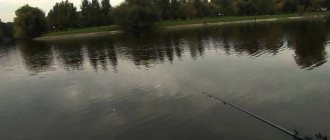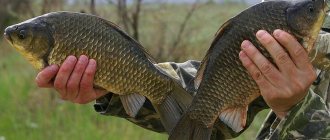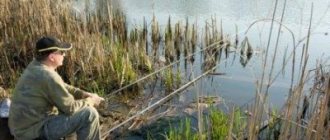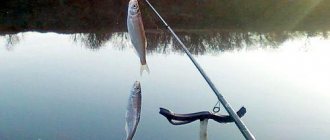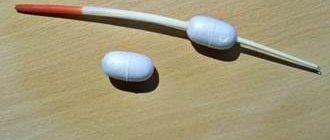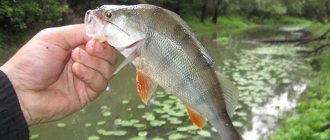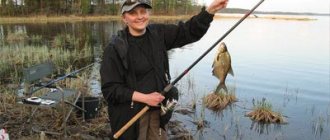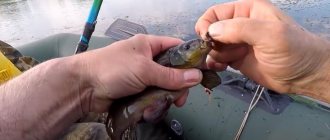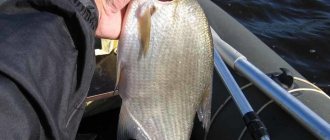The most effective method of catching chub is fishing with a regular float rod. But this does not mean that catching a chub is very easy. To catch him, you need to show maximum patience. At the same time, show some cunning, otherwise the chub will outwit the fisherman. When fishing for chub, you need to very carefully camouflage the hook and camouflage yourself to the fisherman on the shore, without making sudden movements. Suspicious noise on the shore can scare away fish. If you have no experience in such fishing, after reading this article you can partially compensate for the lack of necessary information by learning more about chub fishing, and experience will come with time.
About the chub
The chub belongs to the carp family. It can grow up to 80 cm in length, weighing about 8 kg. As a rule, anglers catch chub weighing no more than 1 kg, although larger specimens are also found. This fish lives from 15 to 18 years. Prefers rivers with clean, cold water and fast currents. A rocky-pebble bottom and many riffles are a must. Like most fish species, the chub is a shy and cautious fish. To catch him, you need to be well camouflaged. Some fishermen catch chub on a spinning rod using various artificial baits, and some fish on a regular float rod using traditional baits. Since there are many more fishing enthusiasts, this article will talk about how to catch this fish on a float.
Lures
A great variety of baits are used for catching chub on a float, which allows the fisherman to experiment and choose the best one:
- Bloodworm
- Maggot
- Chafer
- Grasshopper
- Barley shell meat
- Dough
- Bread
- Berries
In addition to all the baits listed, chub can be caught using cheese. They are caught by first feeding them cheese to the fishing spots for several days. For bait, it is cut into small cubes.
If you take non-hard varieties of cheese, then they are moistened with water, stirred until viscous and rolled into balls. You can catch chub with cheese during the entire period of open water, but this bait works best in the spring.
When and where to catch chub with a regular fishing rod
You can catch it from the moment the ice melts from the river until late autumn. The chub bites throughout the day, from early morning until sunset, as well as at night. The chub is most active early in the morning and late in the evening, when the heat subsides. At night you can catch a trophy specimen, since during this period a large chub goes out to “hunt”.
Chub, like most other fish species, is very sensitive to weather changes, and especially pressure changes. If you do not take this fact into account and go fishing on unstable days, then this fishing may turn out to be a waste of time. Chub are caught when the weather is stable for several days, without obvious changes in temperature and pressure. The chub is less careful during periods when light ripples appear on the water. Therefore, a small breeze can lead to successful fishing, unlike a strong wind, then the fish bite may stop altogether. When the water is clear, this fish feels wary and moves away from the shore when fishermen or extraneous noise appears on it.
The chub loves places where there are riffles and fast currents. When the water temperature drops, it goes to deeper places where the current is not so fast. Can be found in the shade or under the canopy of plants hanging over the water. As a rule, various insects fall into the water from them, which he eats with pleasure. If these are fruit trees, then he can easily taste the fruits of this tree, especially if they are cherry fruits. He never passes by whirlpools into which various spiders, worms, etc. can be sucked. It can be found in sections of the river where mud plays in the water like strands of hair in the wind. Moreover, such places stretch for tens of meters. It can also be found at the boundaries of fast and slow currents, as well as in places where huge boulders peek out of the water, as if cutting through the current. It is behind such boulders that the chub may be located.
If you have some experience in finding chub anchorages, then you can go fishing. It should be taken into account that the places where this fish accumulates depend on the seasons. In the spring, when the water has not yet warmed up, the chub stays closer to the bottom or at half-water. At the same time, it can be found in the area of rifts, where it actively feeds.
Closer to summer, when the upper layers of water are actually warmed up, it rises closer to the surface, where it begins to feed on insects that have fallen into the water. The chub will go to the depths only with the arrival of autumn, when the water temperature begins to drop, and there are no longer food items on the surface of the water. At the same time, the chub’s bite does not stop, but even intensifies, as it senses the coming of winter. If the autumn is warm, then it can peck until November, when real cold is already on the doorstep.
In the autumn, chub can be caught from the depths using bottom tackle. Even on warm, sunny days it remains at depth, in holes, although it can sometimes be seen on sandbanks.
Choosing a place to catch chub with a fishing rod
The chub prefers areas with fast currents and a sandy or clay-rocky bottom. You should not look for it in bays, channels and oxbow lakes, or in silted areas.
Rapids and rifts (areas above and below them) are very promising for catching chub with a fishing rod It is best to present the bait so that it passes through an area of calm water after a roll.
The chub also likes to stay under steep, high banks, under trees and bushes hanging over the water . If it is possible to carry out wiring under a dense bush, you should definitely place the bait here.
The chub loves to hide behind boulders and snags lying in the water. bridge piles and other structures located in the water can become shelters for it .
Reference. You can create an interesting point for catching chub with a fishing rod yourself. To do this, it is enough to cut down a tree on the shore so that it falls into the water, or lower a bush to the bottom, having first tied a weight to its base. On the one hand, they will become a shelter for the chub, behind which it can hide. On the other hand, trees and bushes immersed in water also attract fish because they become a place of attraction for aquatic invertebrates.
What do you use to catch chub?
The chub is a semi-predatory fish, so it is caught using various baits of animal and plant origin. At the same time, there are seasonal approaches to the use of certain baits. In the spring, the most effective bait may be the cockchafer, since it is included in the daily diet of this fish. When the cockchafer begins to become active, quite a lot of it ends up in the water, for one reason or another. When the cockchafer flies out, the chub may completely refuse other food, especially that offered by the fisherman. Fishing can be most productive if you catch chub using a cockchafer.
Until the moment when the cockchafer flies out, the chub is caught using other, well-known baits. The following baits may be most effective:
- Any type of worm.
- Maggot.
- Bloodworm.
- May beetle larva.
- Small fish.
- Barley shell (meat).
- Cancer cervix.
- Bread crust.
- Dough of any origin.
As soon as the cockchafer appears, you should immediately reorient yourself to this effective bait. There are so many chafers that getting them during this period is not particularly difficult; just hit a small tree and they will simply fall on your head. They are collected in a box and sent out for fishing.
The flight of the cockchafer lasts about 2 weeks, after which it is necessary to look for a replacement. In the summer, various caterpillars begin to appear, which can easily replace the May beetle. In addition to caterpillars, grasshoppers are also suitable and can be used throughout the summer. The grasshopper holds the hook perfectly, so there will be no problems with casting, even over long distances. Caterpillars and grasshoppers are used when catching chub directly from the surface of the water.
With the onset of autumn, when the water begins to cool, the chub goes deeper and stays at a depth of half a meter from the bottom. Therefore, during this period it is better to use bottom gear. The feeder is becoming increasingly popular among anglers. This is a bottom fishing rod, equipped with a modern rod and a special feeder, which also serves as a sinker. A grasshopper or caterpillar, if available, is suitable as bait. In addition to them, other baits that were used to catch it in the spring are also suitable. A large chub catches a small frog very well. A small chub will not bite a frog, but a large, trophy specimen will definitely.
There is another interesting bait that the chub will not swim past without becoming interested in it. It turns out that the chub is a cheese lover. The cheese can be cut into cubes comparable to the size of the hook. After this, the cheese cubes are placed on a hook and thrown into the water.
Gear and equipment elements
Choosing a fishing rod
For catching chub on a simple fishing rod with a blind rig, rods of medium length are best suited - about 4-6 m. With shorter ones, in most situations it will not be possible to get the rig to promising points. With a fishing rod longer than 6 m, it becomes difficult to catch a chub. This fish offers quite decent resistance, so you need tackle that will allow you to confidently control a hooked trophy.
Bolognese and match fishing rods are good for catching chub . The first is designed primarily for fishing with long lines, when the equipment is released over several tens of meters. The second is designed for long-cast fishing.
Another advantage of Bolognese and match float fishing rods is that a reel with a friction brake greatly simplifies fishing for chubs. When fishing with a blind rig, it is much more difficult to catch a large fish that has sat on a hook.
Lap dogs and matches require the use of spinning reels, about 2000-3000 in size. With them you can catch chub both in the retrieve and with long casting. If you only intend to fish with wire, you can use an inertial reel. In this case it will be more convenient, but it will not be suitable for long-distance casting of light baits.
This video talks about the types of float rods, what they are, and where to use each type:
Selection of equipment elements
monofilament is used as the main line . Its diameter can be different - depending on the size of the fish, its activity, and the skill of the fisherman. Most often it is 0.25-0.35 mm.
Of the floats, models with spherical, teardrop-shaped or spindle-shaped bodies are usually used. The wider the body of the float, the more confidently it floats on the surface of the water in the current, which is important when hunting for chub with fishing rods.
The tackle must be loaded with several pellets, which should be located on the main line from top to bottom in descending order of size.
It is better to use hooks made of thick wire. The chub has a wide and fleshy mouth, which is quite similar to the mouth of a carp. Small carp hooks are well suited for catching it.
This video gives an overview of the Bolognese fishing rod rig for chub fishing:
Float tackle for chub
The chub is a fairly cautious fish, which means using lines that are not thick or not noticeable in the water. Recently, fishing enthusiasts have begun to prefer fluorocarbon. It is not so noticeable in the water, but it has its disadvantages. It is not as flexible as monofilament line or braided cord. In addition, it has less strength.
If you use a regular fishing line with a diameter of more than 0.25 mm, the number of bites can be significantly reduced. The thickness of the leash should be even less and be within 0.2 mm. It is better to use branded reliable fishing lines with good load capacity, since a large specimen can bite, and you will not be able to pull it ashore without problems. Hooks are used numbers No. 7 or No. 8, with a short shank. The sinker should be located at a distance of no more than 10-15 cm from the hook. A rod at least 3.5 m long with a reel, so that the bait can be released into free swimming when catching chub from the surface. This method of fishing, using baits such as cockchafers, various caterpillars, and grasshoppers, makes fishing more effective than fishing in one place in the water column.
Features of chub spawning
The chub spawning period depends on the specific region, but usually it begins in April and ends in early June. According to fishing tradition, spawning starts at the same time as the bird cherry blossoms. Here one important feature must be taken into account: most fish species almost stop feeding during the spawning period, while the chub continues to feed heavily. Therefore, it is during the spawning period that you can catch many specimens of this greedy fish. But the legislative side of this issue should also be taken into account - in many regions, catching chub and other species is prohibited. The chub reaches its ability to reproduce in the third year. He waits until the water warms up to 10-15 degrees and begins to spawn. To do this, he prefers rocky and pebbly places at the bottom. Large individuals choose deeper places for this process, while small ones choose shallows and riffles. The caviar is small in size and orange in color. One female lays up to a million eggs. A significant part of chub eggs remains unfertilized, so the percentage of chub in comparison with species such as roach and crucian carp is usually small.
Choosing a float for chub
When choosing a float for chub, you should remember that this is a cautious and timid fish that does not tolerate bright colors. This means using subtle float designs that won't alert the fish. You should choose floats that can imitate objects floating on the surface of the water in black, brown or neutral colors. Floats of the “goose feather” type without coloring or floats - bulbs that resemble air bubbles floating on the surface of the water are perfect.
Chub bites
Sometimes it is quite difficult to distinguish chub bites from bites of other fish species. This is also due to the fact that in different bodies of water it bites differently, which indicates the peculiarities of its diet. But, as a rule, the chub’s bites are quite sharp, since it is used to grabbing everything on the move, especially insect larvae that have fallen into the water. About the same time he grabs the bait on the hook. Basically, the bites are quite sharp and unexpected, so you must always be careful not to miss the moment of the bite. If the moment of the bite is missed and the hook is not carried out on time, then the chub will most likely leave with the bait, and the fisherman will pull out the bare hook. Due to the fact that the weight of the sinker is quite small, you should not hope for the fish to hook itself. Self-hooking of a chub is possible when catching it on a feeder, when using feeders weighing about 100 g.
Chub bite pattern
Chub bite
Generally speaking, chub bites are not characterized by a strong difference from other species of fish, which grab prey predatorily and greedily. It is also difficult to give general advice on this issue because in different bodies of water, bites can be of a different nature, depending on what types of food the chub is used to eating in them. But, in general, the chub bites sharply and greedily; in particular, it, without stopping its movement in the water, grabs larval insects. Accordingly, one can expect that he will react in a similar way to bait if he does not recognize danger in it. In this regard, the advice that should be given is that you need to carefully monitor the float and, like a fish biting, make quick and sharp hooks. If you are late with hooking, then there is a high probability that the fish will either spit out the bait or eat it off the hook and leave, leaving the fisherman with only one hook. The mass of the sinker is taken to be small, so one can hardly place high hopes on the likelihood of self-hooking. It can only happen when feeder fishing using heavy feeders. What kind of bait should be prepared for chub It is common knowledge among experienced fishermen that properly prepared and applied bait can increase fishing performance significantly. If we are talking about float fishing for chub, then both universal purchased mixtures and a self-prepared product are suitable. In the latter case, we can recommend such a simple product as bread. Technically, this is done by placing the grain mass in a fine mesh net, tying the net in a knot, and then throwing it into the water using a long rope. In general, since the chub belongs to the carp family, it will use the same bait as carp.
Bait for chub
In order for the fishing results to be significant, it is better to take care of bait that may interest the chub. Here you can use ready-made store-bought mixtures or limit yourself to homemade bait. Oddly enough, you can bait a chub with regular bread. To do this, the bread is placed in a fine mesh net, after which the net is tied like a knot and thrown into the water on a long rope. Considering that the chub is a carp species, you can interest it with the same formulations as for carp.
You can learn about the compositions and methods of preparing such baits here.
Catching chub on a float
The most effective method of catching chub is to use a regular float rod. However, this does not mean that chub are very easy to catch. To catch him, you need to be patient. At the same time, you need to be smart, otherwise the chub will outwit the fisherman. When fishing for chub, try to camouflage the hook and the fisherman on the shore, without making sudden movements. Suspicious sounds on the shore can scare away fish. Having no experience in such fishing, after reading this article, you can partially compensate for the lack of necessary information by learning more about chub fishing, and experience will come with time.
About the chub
The chub belongs to the carp family. It can grow up to 80 cm in length and weigh about 8 kg. As a rule, anglers catch chub weighing less than 1 kg, although sometimes I catch larger specimens. This fish lives from 15 to 18 years. They prefer rivers with clean, cold water and fast currents. There must be a rocky-gravel bottom and many cracks. Like most fish species, the chub is a shy and cautious fish. To catch him, you need to be well camouflaged. Some anglers catch chub on a spinning rod with various artificial baits, and some fish with a regular float rod using traditional baits. Since there are many more fishing enthusiasts, in this article we will tell you how to catch this fish with a float.
When and where to catch chub with a regular fishing rod
They can be caught from the moment the river comes out of the ice until late autumn. It defeats chub all day, from early morning until sunset, and also at night. They are most active early in the morning and late in the evening when the temperature drops. At night you can catch a trophy; large chub come out to hunt.
Chub, like most other fish species, is very sensitive to weather changes, and especially to pressure changes. If you do not take this fact into account and fish on unstable days, such fishing may turn out to be a waste of time. Chub are caught in stable weather for several days without noticeable changes in temperature and pressure. During periods when the water rises slightly, the chub is less careful. A slight breeze can make your fish successful, as opposed to strong winds that can prevent you from catching it at all. When the water is clear, this fish warily moves away from the shore when fishermen or extraneous noise appears.
The chub loves places with cracks and fast currents. When the temperature of the water drops, it flows to a deeper place where the current is not as fast. It can be in the shade or under the canopy of plants hanging over the water. As a rule, various insects fall into the water, which he eats with pleasure. If it is a fruit tree, you can easily taste its fruit, especially if it is a cherry. It never passes through eddies, which can trap various spiders, worms, etc. It can be found in sections of the river where mud plays in the water like strands of hair in the wind. At the same time, such places extend for tens of meters. It is also found at the border between fast and slow currents, as well as in places where large boulders emerge from the water, as if crossing the current. Behind those boulders and maybe a chub.
If you already have experience finding chubs, you can go fishing. It is worth noting that the place where this fish gathers depends on the season. In the spring, when the water has not yet warmed up, chub are more likely to stay closer to the bottom or half of the water. In spring it can also be found in the area of gutters, where it actively feeds.
In the summer, when the upper layers of water really heat up, it rises closer to the surface, where it begins to feed on insects thrown into the water. The chub does not go deeper until the water temperature begins to drop and there are no more things on the surface of the water to feed on. At the same time, the catfish bites do not stop, but even intensify, as it senses the onset of winter. If it is autumn heat, it can bite until November, when it is on the threshold of this cold state.
In autumn, chub can be caught from great depths using bottom gear. Even on warm sunny days it remains at depth, in burrows, although it can sometimes be seen on sandbanks.
What do you use to catch chub?
The chub is a semi-predatory fish, so it is caught using various baits of animal and plant origin. In this case, there are seasonal approaches to the use of certain baits. In the spring, the most effective bait can be the cockchafer, which is part of the daily diet of this fish. When the cockchafer begins to activate, there is quite a lot of it in the water for one reason or another. After the cockchafer leaves, the chub may refuse other food, especially those offered by the fisherman. The most fruitful way to catch chub is with a cockchafer.
Just before the chafers fly away, chubs are caught using another, well-known bait. The following baits may be most effective:
- Any worm. Arrows. Mothballs. May beetle larvae. Little fish. Crustaceans (meat). Neck of crayfish. A crust of bread. Cake of any origin.
As soon as the cockchafer appears, you should immediately focus on this effective bait. There are so many chafers that finding them during this period is not very difficult; just hit a not very large tree and they will fall on your head. You put them in a box and go fishing.
Chub spawning
Depending on the region, chub spawning begins in April and continues until the beginning of June. The beginning of spawning of this fish can be determined by the beginning of bird cherry flowering. Oddly enough, many fish refuse to feed during spawning, but the chub continues to actively feed, so during this period you can count on a good catch. It should be taken into account that during spawning, fishing for many types of fish, including chub, is prohibited. In any case, you need to know when to stop, otherwise, in the near future you may be left without fish at all.
In the third year of life, this fish is ready to reproduce. The spawning process begins with the water warming up to +10-15°C. He chooses places with a rocky and pebble bottom. At the same time, large individuals prefer to lay eggs in deeper places, and smaller individuals prefer to lay eggs in shallows or shallow riffles.
Chub caviar is not large in size, reminiscent of poppy seeds, but orange in color. Each female can lay up to a million eggs. At the same time, the number of chub in reservoirs, compared to roach, crucian carp and other fish, remains small. This is due to the fact that the eggs are carried by a fast current without being fertilized. The rest is destroyed by ubiquitous predators such as perch, pike, etc.
Nozzles for catching chub on shelves
Catching chub on a crust of bread
Chub feeds not only on animal, but also plant prey. Therefore, you can use a variety of attachments on it. The preferences of this fish change depending on the time of year. So, in the spring the cockchafer appears in large quantities. It is this insect that is of the greatest interest to the chub at this time. Therefore, the cockchafer bait is the most effective during this period. You need to wait for the cockchafer to fly out, collect the insects and go with them to the chub. During the period when the cockchafer has not yet appeared, you can use other attachments. A lot of things are suitable: - earthworms and dungworms, maggots, bloodworms, May beetle larvae, live bait, bread crust, dough, crayfish neck. But with the appearance of the cockchafer, if you want to get a serious catch, you should switch to this bait. You need to prepare a box for collecting insects, go into nature and hit any tree. Then the insects will fall off it. But it should be borne in mind that the flight of the cockchafer does not last long - only about two weeks. After this, it will not be so easy to get it. Therefore, you will need to switch to other animal attachments. Caterpillars and grasshoppers will do just fine as a replacement. Grasshoppers can be used throughout the summer. The ability of a grasshopper to stay firmly on a hook is known. But catching this insect is not so easy. Caterpillars and grasshoppers are most attractive to chub in the upper layers and on the surface. In autumn, the chub usually goes deeper and stays in a layer half a meter from the bottom. It was during this period that fishing with a donk, as well as a feeder, became relevant. You can use the types of bait described above, in particular those purchased at a fishing store. We can also recommend another bait - cheese. In autumn, chub readily bite on it. The cheese must be cut into cubes according to the size of the hook.

